2,5-Dimethylfuran Production by Catalytic Hydrogenation of 5-Hydroxymethylfurfural Using Ni Supported on Al2O3-TiO2-ZrO2 Prepared by Sol-Gel Method: The Effect of Hydrogen Donors
Abstract
:1. Introduction
2. Results and Discussion
2.1. Materials Characterization
2.2. Catalytic Tests
2.2.1. Catalytic Activity in CTH of 5-HMF to 2,5-DMF
Effects of Nickel Load and Particle Size
Effect of the Nickel Species of the Ni/ATZ3 Monometallic Catalyst
Effect of the Acid-Basic Sites of the Ni/ATZ3 Monometallic Catalysts
2.2.2. Catalytic Transformation by Hydrogenation (CTH) of 5-HMF over Different Hydrogen Donors
2.2.3. Elucidation by 1H NMR of Products and By-Products of the Conversion of 5-HMF to 2,5-DMF
2.2.4. Recycling Tests of the Ni0NiO/ATZ3WI Catalyst
3. Materials and Methods
3.1. Reagents
3.2. Materials Preparation
3.2.1. Al2O3-TiO2-ZrO2 (ATZX, X = 1,2,3) Supports Preparation by Sol-Gel
3.2.2. Preparation of the Monometallic Ni/ATZX (X = 1, 2, 3) Catalysts by Wet Impregnation (WI)
3.3. Preparation of the Monometallic Ni/ATZX (X = 1, 2, 3) Catalysts by Suspension Method (SM)
3.4. Materials Characterization
3.5. Catalytic Activity Tests
3.5.1. Catalytic Conversion of 2,5-DMF from 5-HMF
3.5.2. Analysis of 2,5-DMF by Gas Chromatography (GC)
3.5.3. Analysis of 5-HMF Conversion by High-Performance Liquid Chromatography (HPLC)
3.5.4. Analysis of HMF Reaction Products by 1H NMR Spectroscopy
4. Conclusions
Author Contributions
Funding
Institutional Review Board Statement
Informed Consent Statement
Data Availability Statement
Acknowledgments
Conflicts of Interest
References
- Guo, D.; Liu, X.; Cheng, F.; Zhao, W.; Wen, S.; Xiang, Y.; Xu, Q.; Yu, N.; Yin, D. Selective Hydrogenolysis of 5-Hydroxymethylfurfural to Produce Biofuel 2,5-Dimethylfuran over Ni/ZSM-5 Catalysts. Fuel 2020, 274, 117853. [Google Scholar] [CrossRef]
- Wang, H.; Zhu, C.; Li, D.; Liu, Q.; Tan, J.; Wang, C.; Cai, C.; Ma, L. Recent Advances in Catalytic Conversion of Biomass to 5-Hydroxymethylfurfural and 2,5-Dimethylfuran. Renew. Sustain. Energy Rev. 2019, 103, 227–247. [Google Scholar] [CrossRef]
- Ge, X.; Chang, C.; Zhang, L.; Cui, S.; Luo, X.; Hu, S.; Qin, Y.; Li, Y. Conversion of Lignocellulosic Biomass into Platform Chemicals for Biobased Polyurethane Application. In Advances in Bioenergy; Elsevier: Amsterdam, The Netherlands, 2018; Volume 3, pp. 161–213. [Google Scholar] [CrossRef]
- Hu, L.; Li, T.; Xu, J.; He, A.; Tang, X.; Chu, X.; Xu, J. Catalytic Transfer Hydrogenation of Biomass-Derived 5-Hydroxymethylfurfural into 2,5-Dihydroxymethylfuran over Magnetic Zirconium-Based Coordination Polymer. Chem. Eng. J. 2018, 352, 110–119. [Google Scholar] [CrossRef]
- Li, H.; Yang, S.; Riisager, A.; Pandey, A.; Sangwan, R.S.; Saravanamurugan, S.; Luque, R. Zeolite and Zeotype-Catalysed Transformations of Biofuranic Compounds. Green Chem. 2016, 18, 5701–5735. [Google Scholar] [CrossRef]
- Hoang, A.T.; Nižetić, S.; Ölçer, A.I. 2,5-Dimethylfuran (DMF) as a Promising Biofuel for the Spark Ignition Engine Application: A Comparative Analysis and Review. Fuel 2021, 285, 119140. [Google Scholar] [CrossRef]
- Esteves, L.M.; Brijaldo, M.H.; Oliveira, E.G.; Martinez, J.J.; Rojas, H.; Caytuero, A.; Passos, F.B. Effect of Support on Selective 5-Hydroxymethylfurfural Hydrogenation towards 2,5-Dimethylfuran over Copper Catalysts. Fuel 2020, 270, 117524. [Google Scholar] [CrossRef]
- Yang, P.; Xia, Q.; Liu, X.; Wang, Y. Catalytic Transfer Hydrogenation/Hydrogenolysis of 5-Hydroxymethylfurfural to 2,5-Dimethylfuran over Ni-Co/C Catalyst. Fuel 2017, 187, 159–166. [Google Scholar] [CrossRef]
- Chen, S.; Ciotonea, C.; Ungureanu, A.; Dumitriu, E.; Catrinescu, C.; Wojcieszak, R.; Dumeignil, F.; Royer, S. Preparation of Nickel (Oxide) Nanoparticles Confined in the Secondary Pore Network of Mesoporous Scaffolds Using Melt Infiltration. Catal. Today 2019, 334, 48–58. [Google Scholar] [CrossRef]
- Siddiqui, N.; Singha Roy, A.; Goyal, R.; Khatun, R.; Pendem, C.; Naidu Chokkapu, A.; Bordoloi, A.; Bal, R. Hydrogenation of 5-Hydroxymethylfurfural to 2,5 Dimethylfuran over Nickel Supported Tungsten Oxide Nanostructured Catalyst. Sustain. Energy Fuels 2018, 2, 191–198. [Google Scholar] [CrossRef]
- Lima, S.; Chadwick, D.; Hellgardt, K. Towards Sustainable Hydrogenation of 5-(Hydroxymethyl)Furfural: A Two-Stage Continuous Process in Aqueous Media over RANEY® Catalysts. RSC Adv. 2017, 7, 31401–31407. [Google Scholar] [CrossRef] [Green Version]
- Kong, X.; Zhu, Y.; Zheng, H.; Dong, F.; Zhu, Y.; Li, Y. Switchable Synthesis of 2,5-Dimethylfuran and 2,5-Dihydroxymethyltetrahydrofuran from 5-Hydroxymethylfurfural over Raney Ni Catalyst. RSC Adv. 2014, 4, 60467–60472. [Google Scholar] [CrossRef]
- Zhu, C.; Liu, Q.; Li, D.; Wang, H.; Zhang, C.; Cui, C.; Chen, L.; Cai, C.; Ma, L. Selective Hydrodeoxygenation of 5-Hydroxymethylfurfural to 2,5-Dimethylfuran over Ni Supported on Zirconium Phosphate Catalysts. ACS Omega 2018, 3, 7407–7417. [Google Scholar] [CrossRef] [Green Version]
- Kong, X.; Zhu, Y.; Zheng, H.; Li, X.; Zhu, Y.; Li, Y.-W. Ni Nanoparticles Inlaid Nickel Phyllosilicate as a Metal–Acid Bifunctional Catalyst for Low-Temperature Hydrogenolysis Reactions. ACS Catal. 2015, 5, 5914–5920. [Google Scholar] [CrossRef]
- Kong, X.; Zheng, R.; Zhu, Y.; Ding, G.; Zhu, Y.; Li, Y.-W. Rational Design of Ni-Based Catalysts Derived from Hydrotalcite for Selective Hydrogenation of 5-Hydroxymethylfurfural. Green Chem. 2015, 17, 2504–2514. [Google Scholar] [CrossRef]
- Fulajtárová, K.; Hronec, M.; Liptaj, T. Catalytic Hydrogenation of Condensation Product of Furfural with Cyclopentanone Using Molecular Hydrogen and Formic Acid as Hydrogen Donor. J. Taiwan Inst. Chem. Eng. 2016, 66, 137–142. [Google Scholar] [CrossRef]
- Han, W.; Tang, M.; Li, J.; Li, X.; Wang, J.; Zhou, L.; Yang, Y.; Wang, Y.; Ge, H. Selective Hydrogenolysis of 5-Hydroxymethylfurfural to 2,5-Dimethylfuran Catalyzed by Ordered Mesoporous Alumina Supported Nickel-Molybdenum Sulfide Catalysts. Appl. Catal. B Environ. 2020, 268, 118748. [Google Scholar] [CrossRef]
- Jae, J.; Zheng, W.; Lobo, R.F.; Vlachos, D.G. Production of Dimethylfuran from Hydroxymethylfurfural through Catalytic Transfer Hydrogenation with Ruthenium Supported on Carbon. ChemSusChem 2013, 6, 1158–1162. [Google Scholar] [CrossRef]
- Ortega-Domínguez, R.A.; Vargas-Villagrán, H.; Peñaloza-Orta, C.; Saavedra-Rubio, K.; Bokhimi, X.; Klimova, T.E. A Facile Method to Increase Metal Dispersion and Hydrogenation Activity of Ni/SBA-15 Catalysts. Fuel 2017, 198, 110–122. [Google Scholar] [CrossRef]
- Castro, J. Integración de Los Procesos Heterogéneos En El Análisis de La Cinética de Producción de Biodiésel Usando Enzimas Inmovilizadas En Un Reactor Por Lotes. MSc Thesis, Universidad Nacional de Columbia, Medellín, Columbia, April 2017. [Google Scholar]
- Chaudhary, M.; Shen, P.; Chang, S. The Roles of Phosphate and Tungstate Species in Surface Acidities of TiO2–ZrO2 Binary Oxides—A Comparison Study. Appl. Surf. Sci. 2018, 440, 369–377. [Google Scholar] [CrossRef]
- Manríquez, M.E.; López, T.; Gómez, R.; Navarrete, J. Preparation of TiO2–ZrO2 Mixed Oxides with Controlled Acid–Basic Properties. J. Mol. Catal. Chem. 2004, 220, 229–237. [Google Scholar] [CrossRef]
- Walton, I.M.; Cox, J.M.; Benson, C.A.; Patel, D.D.G.; Chen, Y.-S.; Benedict, J.B. The Role of Atropisomers on the Photo-Reactivity and Fatigue of Diarylethene-Based Metal–Organic Frameworks. New J. Chem. 2016, 40, 101–106. [Google Scholar] [CrossRef]
- Rao, K.N.; Reddy, B.M.; Abhishek, B.; Seo, Y.-H.; Jiang, N.; Park, S.-E. Effect of Ceria on the Structure and Catalytic Activity of V2O5/TiO2–ZrO2 for Oxidehydrogenation of Ethylbenzene to Styrene Utilizing CO2 as Soft Oxidant. Appl. Catal. B Environ. 2009, 91, 649–656. [Google Scholar] [CrossRef]
- Burri, A.; Jiang, N.; Park, S.-E. High Surface Area TiO2–ZrO2 Prepared by Caustic Solution Treatment, and Its Catalytic Efficiency in the Oxidehydrogenation of Para-Ethyltoluene by CO2. Catal. Sci. Technol. 2012, 2, 514–520. [Google Scholar] [CrossRef]
- El Doukkali, M.; Iriondo, A.; Arias, P.L.; Requies, J.; Gandarías, I.; Jalowiecki-Duhamel, L.; Dumeignil, F. A Comparison of Sol–Gel and Impregnated Pt or/and Ni Based γ-Alumina Catalysts for Bioglycerol Aqueous Phase Reforming. Appl. Catal. B Environ. 2012, 125, 516–529. [Google Scholar] [CrossRef]
- Jafari, A.; Pilban Jahromi, S.; Boustani, K.; Goh, B.T.; Huang, N.M. Evolution of Structural and Magnetic Properties of Nickel Oxide Nanoparticles: Influence of Annealing Ambient and Temperature. J. Magn. Magn. Mater. 2019, 469, 383–390. [Google Scholar] [CrossRef]
- Kiritani, M. Similarity and Difference between fcc, bcc and hcp Metals from the View Point of Point Defect Cluster Formation. J. Nucl. Mater. 2000, 276, 41–49. [Google Scholar] [CrossRef]
- Anitha, V.C.; Banerjee, A.N.; Joo, S.W. Recent Developments in TiO2 as N- and p-Type Transparent Semiconductors: Synthesis, Modification, Properties, and Energy-Related Applications. J. Mater. Sci. 2015, 50, 7495–7536. [Google Scholar] [CrossRef]
- Zhang, W.; Zhu, Y.; Xu, H.; Gaborieau, M.; Huang, J.; Jiang, Y. Glucose Conversion to 5-Hydroxymethylfurfural on Zirconia: Tuning Surface Sites by Calcination Temperatures. Catal. Today 2018, 351, 133–140. [Google Scholar] [CrossRef]
- Radi, P.A.; Testoni, G.E.; Pessoa, R.S.; Maciel, H.S.; Rocha, L.A.; Vieira, L. Tribocorrosion Behavior of TiO2/Al2O3 Nanolaminate, Al2O3, and TiO2 Thin Films Produced by Atomic Layer Deposition. Surf. Coat. Technol. 2018, 349, 1077–1082. [Google Scholar] [CrossRef] [Green Version]
- George, G.; Anandhan, S. Synthesis and Characterisation of Nickel Oxide Nanofibre Webs with Alcohol Sensing Characteristics. RSC Adv. 2014, 4, 62009–62020. [Google Scholar] [CrossRef]
- Jena, A.; Munichandraiah, N.; Shivashankar, S.A. Carbonaceous Nickel Oxide Nano-Composites: As Electrode Materials in Electrochemical Capacitor Applications. J. Power Sources 2013, 237, 156–166. [Google Scholar] [CrossRef]
- Argolo, M.I.S.; Silva, L.S.; Siqueira, J.M.; da Miranda, S.F.; Medeiros, M.E.; Garrido, F.M.S. Structural and Optical Properties of Ni/NiO Composites Synthesized by Eco-Friendly Self-Propagation Synthesis (SHS): Effects of NH4OH Addition. Ceram. Int. 2019, 45, 21640–21646. [Google Scholar] [CrossRef]
- Dong, D.; Wang, W.; Barnabé, A.; Presmanes, L.; Rougier, A.; Dong, G.; Zhang, F.; Yu, H.; He, Y.; Diao, X. Enhanced Electrochromism in Short Wavelengths for NiO:(Li, Mg) Films in Full Inorganic Device ITO/NiO:(Li, Mg)/Ta2O5/WO3/ITO. Electrochim. Acta 2018, 263, 277–285. [Google Scholar] [CrossRef] [Green Version]
- Ganeshchandra Prabhu, V.; Paloly, A.R.; Divya, N.G.; Bushiri, M.J. Photocatalytic and Ferromagnetic Properties of Electrically Conducting Multifunctional Ni/NiO Nanocomposites in Amorphous Carbon Matrix. Mater. Sci. Eng. B 2018, 228, 132–141. [Google Scholar] [CrossRef]
- Bhanuchandar, S.; Vinothkumar, G.; Arunkumar, P.; Sribalaji, M.; Keshri, A.K.; Suresh Babu, K. Controlled Growth of Ni/NiO Composite Nanoparticles and Its Influence on Exchange Anisotropy and Spin Glass Features. J. Alloys Compd. 2019, 780, 256–265. [Google Scholar] [CrossRef]
- Gutiérrez-Alejandre, A.; Ramírez, J.; Val, I.J.; Peñuelas-Galaz, M.; Sánchez-Neri, P.; Torres-Mancera, P. Activity of NiW Catalysts Supported on TiO2–Al2O3 Mixed Oxides. Catal. Today 2005, 107–108, 879–884. [Google Scholar] [CrossRef]
- Das, D. Preparation, Physico-Chemical Characterization and Catalytic Activity of Sulphated ZrO2–TiO2 Mixed Oxides. J. Mol. Catal. Chem. 2002, 189, 271–282. [Google Scholar] [CrossRef]
- Ulín, C.A.; De Los Reyes, J.A.; Escobar, J.; Barrera, M.C.; Cortés-Jacome, M.A. Mesoporous (ZrO2–TiO2)/Al2O3 Ternary Carriers as Hydrodesulfurization Catalysts Support. J. Phys. Chem. Solids 2010, 71, 1004–1012. [Google Scholar] [CrossRef]
- Thejaswini, T.V.L.; Prabhakaran, D.; Maheswari, M.A. Synthesis of Mesoporous Worm-like ZrO2–TiO2 Monoliths and Their Photocatalytic Applications towards Organic Dye Degradation. J. Photochem. Photobiol. Chem. 2017, 344, 212–222. [Google Scholar] [CrossRef]
- Mitrici, S.; Rada, S.; Culea, E.; Pop, L.; Popa, A.; Bot, A.; Macavei, S.; Pana, O.; David, L. Nickel-Lead-Borate Glasses and Vitroceramics with Antiferromagnetic NiO and Nickel-Orthoborate Crystalline Phases. J. Non-Cryst. Solids 2017, 471, 349–356. [Google Scholar] [CrossRef]
- Mahesh, K.P.O.; Kuo, D.-H. Synthesis of Ni Nanoparticles Decorated SiO2/TiO2 Magnetic Spheres for Enhanced Photocatalytic Activity towards the Degradation of Azo Dye. Appl. Surf. Sci. 2015, 357, 433–438. [Google Scholar] [CrossRef]
- Jung, M.; Choi, Y.-W. Comparative Study on Plasmonic Properties of a Ni Film and 2D Ni Nanodot Array Fabricated on an ITO Substrate. Mater. Lett. 2017, 204, 49–52. [Google Scholar] [CrossRef]
- Chang, X.; Liu, B.; Xia, H.; Amin, R. High Catalytic Activity and Stability of Ni/CexZr1−xO2/MSU-H for CH4/CO2 Reforming Reaction. Appl. Surf. Sci. 2018, 442, 342–351. [Google Scholar] [CrossRef]
- Damyanova, S.; Pawelec, B.; Palcheva, R.; Karakirova, Y.; Sanchez, M.C.C.; Tyuliev, G.; Gaigneaux, E.; Fierro, J.L.G. Structure and Surface Properties of Ceria-Modified Ni-Based Catalysts for Hydrogen Production. Appl. Catal. B Environ. 2018, 225, 340–353. [Google Scholar] [CrossRef]
- Zhang, Z.; Tang, M.; Chen, J. Effects of P/Ni Ratio and Ni Content on Performance of γ-Al2O3-Supported Nickel Phosphides for Deoxygenation of Methyl Laurate to Hydrocarbons. Appl. Surf. Sci. 2016, 360, 353–364. [Google Scholar] [CrossRef]
- Gil-Calvo, M.; Jiménez-González, C.; de Rivas, B.; Gutiérrez-Ortiz, J.I.; López-Fonseca, R. Effect of Ni/Al Molar Ratio on the Performance of Substoichiometric NiAl2O4 Spinel-Based Catalysts for Partial Oxidation of Methane. Appl. Catal. B Environ. 2017, 209, 128–138. [Google Scholar] [CrossRef]
- He, S.; Zhang, L.; He, S.; Mo, L.; Zheng, X.; Wang, H.; Luo, Y. Ni/SiO2 Catalyst Prepared with Nickel Nitrate Precursor for Combination of CO2 Reforming and Partial Oxidation of Methane: Characterization and Deactivation Mechanism Investigation. J. Nanomater. 2015, 2015, 659402. [Google Scholar] [CrossRef] [Green Version]
- Soltani, R.; Shahvar, A.; Dinari, M.; Saraji, M. Environmentally-Friendly and Ultrasonic-Assisted Preparation of Two-Dimensional Ultrathin Ni/Co-NO3 Layered Double Hydroxide Nanosheet for Micro Solid-Phase Extraction of Phenolic Acids from Fruit Juices. Ultrason. Sonochem. 2018, 40, 395–401. [Google Scholar] [CrossRef] [PubMed]
- Chong, C.C.; Owgi, A.H.K.; Ainirazali, N.; Chin, S.Y.; Setiabudi, H.D. CO2 Reforming of CH4 over Ni/SBA-15 Prepared by Surfactant-Assisted Impregnation Method: Comparative Study of Surfactant Types. Mater. Today Proc. 2018, 5, 21644–21651. [Google Scholar] [CrossRef]
- Farhadi, S.; Roostaei-Zaniyani, Z. Preparation and Characterization of NiO Nanoparticles from Thermal Decomposition of the [Ni(En)3](NO3)2 Complex: A Facile and Low-Temperature Route. Polyhedron 2011, 30, 971–975. [Google Scholar] [CrossRef]
- Edgardo, M.F.; Maria do Carmo, R. Síntesis de catalizadores de Ni/ZnO/Al2O3 para la reacción wgs a través del estudio de las propiedades estructurales y catalíticas de Ni/ZnO y M/Al2O3. Rev. Colomb. Quím. 2011, 40, 105–123. [Google Scholar]
- Li, B.; Lin, X.; Luo, Y.; Yuan, X.; Wang, X. Design of Active and Stable Bimodal Nickel Catalysts for Methane Reforming with CO2. Fuel Process. Technol. 2018, 176, 153–166. [Google Scholar] [CrossRef]
- Zhang, Q.; Long, K.; Wang, J.; Zhang, T.; Song, Z.; Lin, Q. A Novel Promoting Effect of Chelating Ligand on the Dispersion of Ni Species over Ni/SBA-15 Catalyst for Dry Reforming of Methane. Int. J. Hydrogen Energy 2017, 42, 14103–14114. [Google Scholar] [CrossRef]
- Guo, S.; Wang, J.; Ding, C.; Duan, Q.; Ma, Q.; Zhang, K.; Liu, P. Confining Ni Nanoparticles in Honeycomb-like Silica for Coking and Sintering Resistant Partial Oxidation of Methane. Int. J. Hydrogen Energy 2018, 43, 6603–6613. [Google Scholar] [CrossRef]
- Rodemerck, U.; Schneider, M.; Linke, D. Improved Stability of Ni/SiO2 Catalysts in CO2 and Steam Reforming of Methane by Preparation via a Polymer-Assisted Route. Catal. Commun. 2017, 102, 98–102. [Google Scholar] [CrossRef]
- Wang, Y.; Wang, W.; Hong, X.; Li, B. Zirconia Promoted Metallic Nickel Catalysts for the Partial Oxidation of Methane to Synthesis Gas. Catal. Commun. 2009, 10, 940–944. [Google Scholar] [CrossRef]
- Lino, A.V.P.; Assaf, E.M.; Assaf, J.M. Hydrotalcites Derived Catalysts for Syngas Production from Biogas Reforming: Effect of Nickel and Cerium Load. Catal. Today 2017, 289, 78–88. [Google Scholar] [CrossRef]
- Mihet, M.; Lazar, M.D. Methanation of CO2 on Ni/γ-Al2O3: Influence of Pt, Pd or Rh Promotion. Catal. Today 2018, 306, 294–299. [Google Scholar] [CrossRef]
- He, Z.; Wang, X.; Liu, R.; Gao, S.; Xiao, T. Perfomances of Different Additives on NiO/γ-Al2O3 Catalyst in CO Methanation. Appl. Petrochem. Res. 2016, 6, 235–241. [Google Scholar] [CrossRef] [Green Version]
- Mebrahtu, C.; Abate, S.; Perathoner, S.; Chen, S.; Centi, G. CO2 Methanation over Ni Catalysts Based on Ternary and Quaternary Mixed Oxide: A Comparison and Analysis of the Structure-Activity Relationships. Catal. Today 2018, 304, 181–189. [Google Scholar] [CrossRef]
- Srinivasa Rao, B.; Krishna Kumari, P.; Dhana Lakshmi, D.; Nakka, L. One Pot Selective Transformation of Biomass Derived Chemicals towards Alkyl Levulinates over Titanium Exchanged Heteropoly Tungstate Catalysts. Catal. Today 2018, 309, 269–275. [Google Scholar] [CrossRef]
- Radziuk, D.; Möhwald, H. Ultrasonically Treated Liquid Interfaces for Progress in Cleaning and Separation Processes. Phys. Chem. Chem. Phys. 2016, 18, 21–46. [Google Scholar] [CrossRef]
- Zakharova, M.V.; Kleitz, F.; Fontaine, F.-G. Lewis Acidity Quantification and Catalytic Activity of Ti, Zr and Al-Supported Mesoporous Silica. Dalton Trans. 2017, 46, 3864–3876. [Google Scholar] [CrossRef] [Green Version]
- Leal, G.F.; Lima, S.; Graça, I.; Carrer, H.; Barrett, D.H.; Teixeira-Neto, E.; Curvelo, A.A.S.; Rodella, C.B.; Rinaldi, R. Design of Nickel Supported on Water-Tolerant Nb2O5 Catalysts for the Hydrotreating of Lignin Streams Obtained from Lignin-First Biorefining. iScience 2019, 15, 467–488. [Google Scholar] [CrossRef] [Green Version]
- Regalbuto, J.R. (Ed.) Catalyst Preparation: Science and Engineering; Taylor & Francis: Boca Raton, FL, USA, 2007. [Google Scholar]
- Gong, W.; Chen, C.; Zhang, H.; Zhang, Y.; Zhang, Y.; Wang, G.; Zhao, H. Highly Selective Liquid-Phase Hydrogenation of Furfural over N-Doped Carbon Supported Metallic Nickel Catalyst under Mild Conditions. Mol. Catal. 2017, 429, 51–59. [Google Scholar] [CrossRef]
- Alnarabiji, M.S.; Mohd Zabidi, N.A.; Ramli, A.; Ghanem, O.B.; Abdullah, B. Controllable Green Synthesis of Supported Hollow NiO Crystals with Shape Evolution from Octahedral to Novel Truncated Octahedral. CrystEngComm 2018, 20, 6662–6666. [Google Scholar] [CrossRef]
- Lin, L.; Liu, T.; Miao, B.; Zeng, W. Hydrothermal Fabrication of Uniform Hexagonal NiO Nanosheets: Structure, Growth and Response. Mater. Lett. 2013, 102–103, 43–46. [Google Scholar] [CrossRef]
- Kho, E.T.; Jantarang, S.; Zheng, Z.; Scott, J.; Amal, R. Harnessing the Beneficial Attributes of Ceria and Titania in a Mixed-Oxide Support for Nickel-Catalyzed Photothermal CO2 Methanation. Engineering 2017, 3, 393–401. [Google Scholar] [CrossRef]
- Singh, H.; Rai, A.; Yadav, R.; Sinha, A.K. Glucose Hydrogenation to Sorbitol over Unsupported Mesoporous Ni/NiO Catalyst. Mol. Catal. 2018, 451, 186–191. [Google Scholar] [CrossRef]
- Zheng, Y.; Zhu, B.; Chen, H.; You, W.; Jiang, C.; Yu, J. Hierarchical Flower-like Nickel(II) Oxide Microspheres with High Adsorption Capacity of Congo Red in Water. J. Colloid Interface Sci. 2017, 504, 688–696. [Google Scholar] [CrossRef]
- Alnarabiji, M.S.; Tantawi, O.; Ramli, A.; Mohd Zabidi, N.A.; Ghanem, O.B.; Abdullah, B. Comprehensive Review of Structured Binary Ni-NiO Catalyst: Synthesis, Characterization and Applications. Renew. Sustain. Energy Rev. 2019, 114, 109326. [Google Scholar] [CrossRef]
- Choi, Y.; Kim, N.D.; Baek, J.; Kim, W.; Lee, H.J.; Yi, J. Effect of N2O-Mediated Calcination on Nickel Species and the Catalytic Activity of Nickel Catalysts Supported on γ-Al2O3 in the Steam Reforming of Glycerol. Int. J. Hydrogen Energy 2011, 36, 3844–3852. [Google Scholar] [CrossRef]
- Garbarino, G.; Riani, P.; Infantes-Molina, A.; Rodríguez-Castellón, E.; Busca, G. On the Detectability Limits of Nickel Species on NiO/γ-Al2O3 Catalytic Materials. Appl. Catal. Gen. 2016, 525, 180–189. [Google Scholar] [CrossRef]
- Wang, J.; Jaenicke, S.; Chuah, G.-K. Zirconium–Beta Zeolite as a Robust Catalyst for the Transformation of Levulinic Acid to γ-Valerolactone via Meerwein–Ponndorf–Verley Reduction. RSC Adv. 2014, 4, 13481–13489. [Google Scholar] [CrossRef]
- Chen, M.-Y.; Chen, C.-B.; Zada, B.; Fu, Y. Perovskite Type Oxide-Supported Ni Catalysts for the Production of 2,5-Dimethylfuran from Biomass-Derived 5-Hydroxymethylfurfural. Green Chem. 2016, 18, 3858–3866. [Google Scholar] [CrossRef]
- Song, S.; Yao, S.; Cao, J.; Di, L.; Wu, G.; Guan, N.; Li, L. Heterostructured Ni/NiO Composite as a Robust catalyst for the hydrogenation of levulinic acid to γ-valerolactone. Appl. Catal. B Environ. 2017, 217, 115–124. [Google Scholar] [CrossRef]
- Sun, Y.; Xiong, C.; Liu, Q.; Zhang, J.; Tang, X.; Zeng, X.; Liu, S.; Lin, L. Catalytic Transfer Hydrogenolysis/Hydrogenation of Biomass-Derived 5-Formyloxymethylfurfural to 2,5-Dimethylfuran over Ni–Cu Bimetallic Catalyst with Formic Acid as a Hydrogen Donor. Ind. Eng. Chem. Res. 2019, 58, 5414–5422. [Google Scholar] [CrossRef]
- Hansen, T.S.; Barta, K.; Anastas, P.T.; Ford, P.C.; Riisager, A. One-Pot Reduction of 5-Hydroxymethylfurfural via Hydrogen Transfer from Supercritical Methanol. Green Chem. 2012, 14, 2457. [Google Scholar] [CrossRef] [Green Version]
- Shafaghat, H.; Lee, I.-G.; Jae, J.; Jung, S.-C.; Park, Y.-K. Pd/C Catalyzed Transfer Hydrogenation of Pyrolysis Oil Using 2-Propanol as Hydrogen Source. Chem. Eng. J. 2019, 377, 119986. [Google Scholar] [CrossRef]
- Valentini, F.; Kozell, V.; Petrucci, C.; Marrocchi, A.; Gu, Y.; Gelman, D.; Vaccaro, L. Formic Acid, a Biomass-Derived Source of Energy and Hydrogen for Biomass Upgrading. Energy Environ. Sci. 2019, 12, 2646–2664. [Google Scholar] [CrossRef]
- Thananatthanachon, T.; Rauchfuss, T.B. Efficient Production of the Liquid Fuel 2,5-Dimethylfuran from Fructose Using Formic Acid as a Reagent. Angew. Chem. Int. Ed. 2010, 49, 6616–6618. [Google Scholar] [CrossRef]
- Tao, L.; Yan, T.-H.; Li, W.; Zhao, Y.; Zhang, Q.; Liu, Y.-M.; Wright, M.M.; Li, Z.-H.; He, H.-Y.; Cao, Y. Toward an Integrated Conversion of 5-Hydroxymethylfurfural and Ethylene for the Production of Renewable p-Xylene. Chem 2018, 4, 2212–2227. [Google Scholar] [CrossRef] [Green Version]
- Gupta, D.; Kumar, R.; Pant, K.K. Hydrotalcite Supported Bimetallic (Ni-Cu) Catalyst: A Smart Choice for One-Pot Conversion of Biomass-Derived Platform Chemicals to Hydrogenated Biofuels. Fuel 2020, 277, 118111. [Google Scholar] [CrossRef]
- Bui, L.; Luo, H.; Gunther, W.R.; Román-Leshkov, Y. Domino Reaction Catalyzed by Zeolites with Brønsted and Lewis Acid Sites for the Production of γ-Valerolactone from Furfural. Angew. Chem. Int. Ed. 2013, 52, 8022–8025. [Google Scholar] [CrossRef]
- Chen, S.; Wojcieszak, R.; Dumeignil, F.; Marceau, E.; Royer, S. How Catalysts and Experimental Conditions Determine the Selective Hydroconversion of Furfural and 5-Hydroxymethylfurfural. Chem. Rev. 2018, 118, 11023–11117. [Google Scholar] [CrossRef] [Green Version]
- Hu, L.; Tang, X.; Xu, J.; Wu, Z.; Lin, L.; Liu, S. Selective Transformation of 5-Hydroxymethylfurfural into the Liquid Fuel 2,5-Dimethylfuran over Carbon-Supported Ruthenium. Ind. Eng. Chem. Res. 2014, 53, 3056–3064. [Google Scholar] [CrossRef]
- Hengne, A.M.; Rode, C.V. Cu–ZrO2 nanocomposite catalyst for selective hydrogenation of levulinic acid and its ester to γ-valerolactone. Green Chem. 2012, 14, 1064–1072. [Google Scholar] [CrossRef]
- Miao, C.; Zhou, G.; Chen, S.; Xie, H.; Zhang, X. Synergistic Effects between Cu and Ni Species in NiCu/γ-Al2O3 Catalysts for Hydrodeoxygenation of Methyl Laurate. Renew. Energy 2020, 153, 1439–1454. [Google Scholar] [CrossRef]
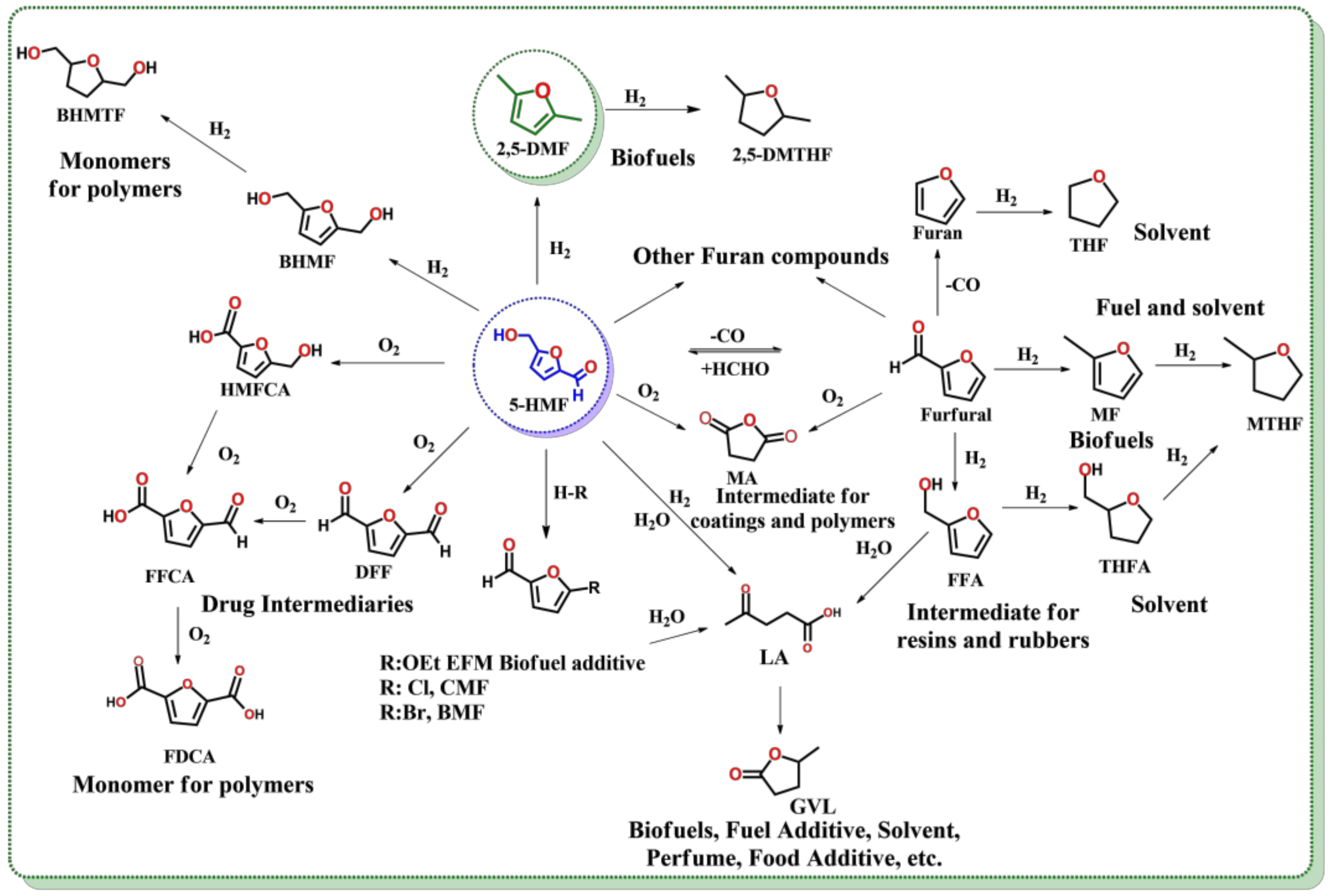
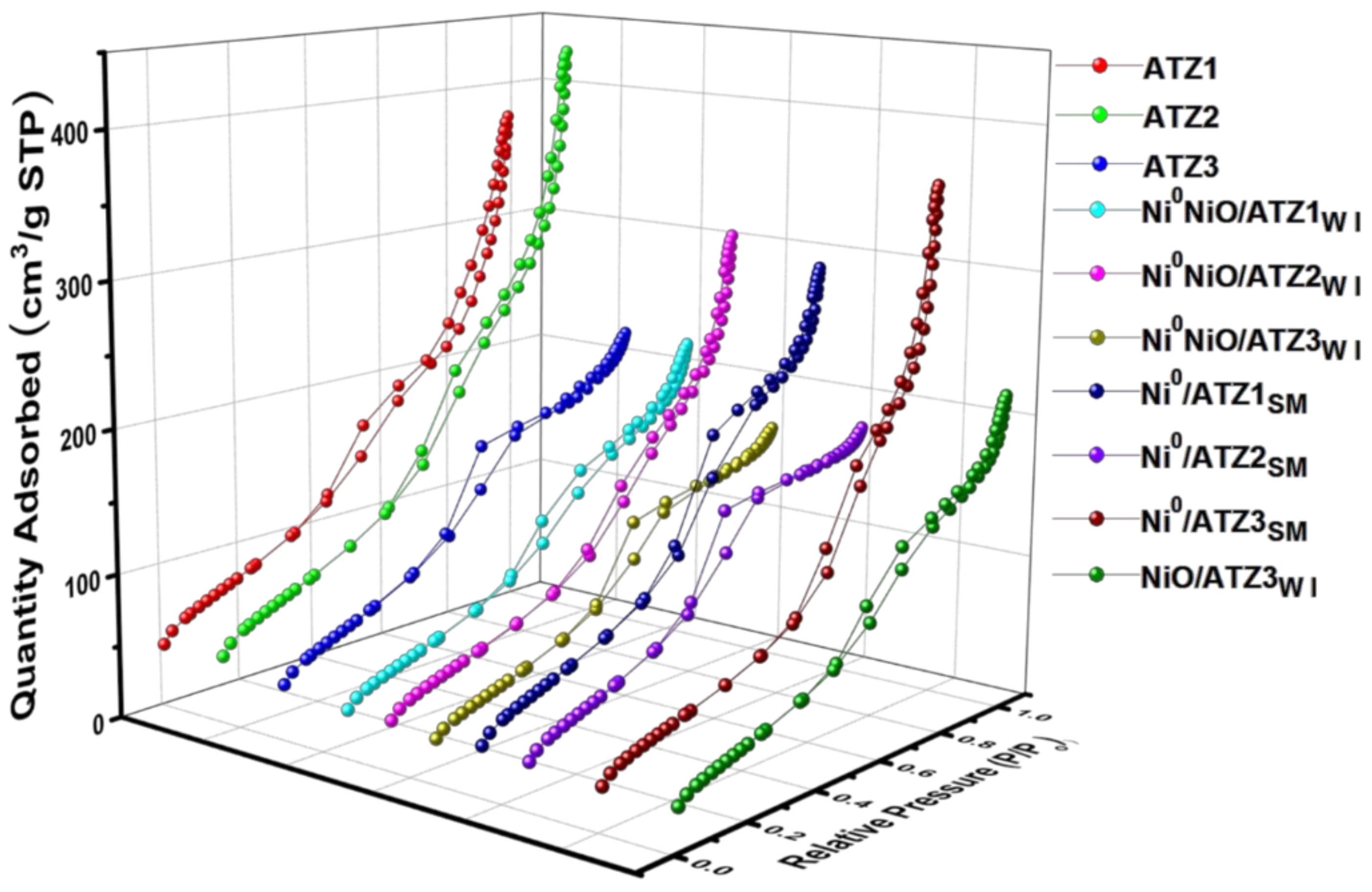

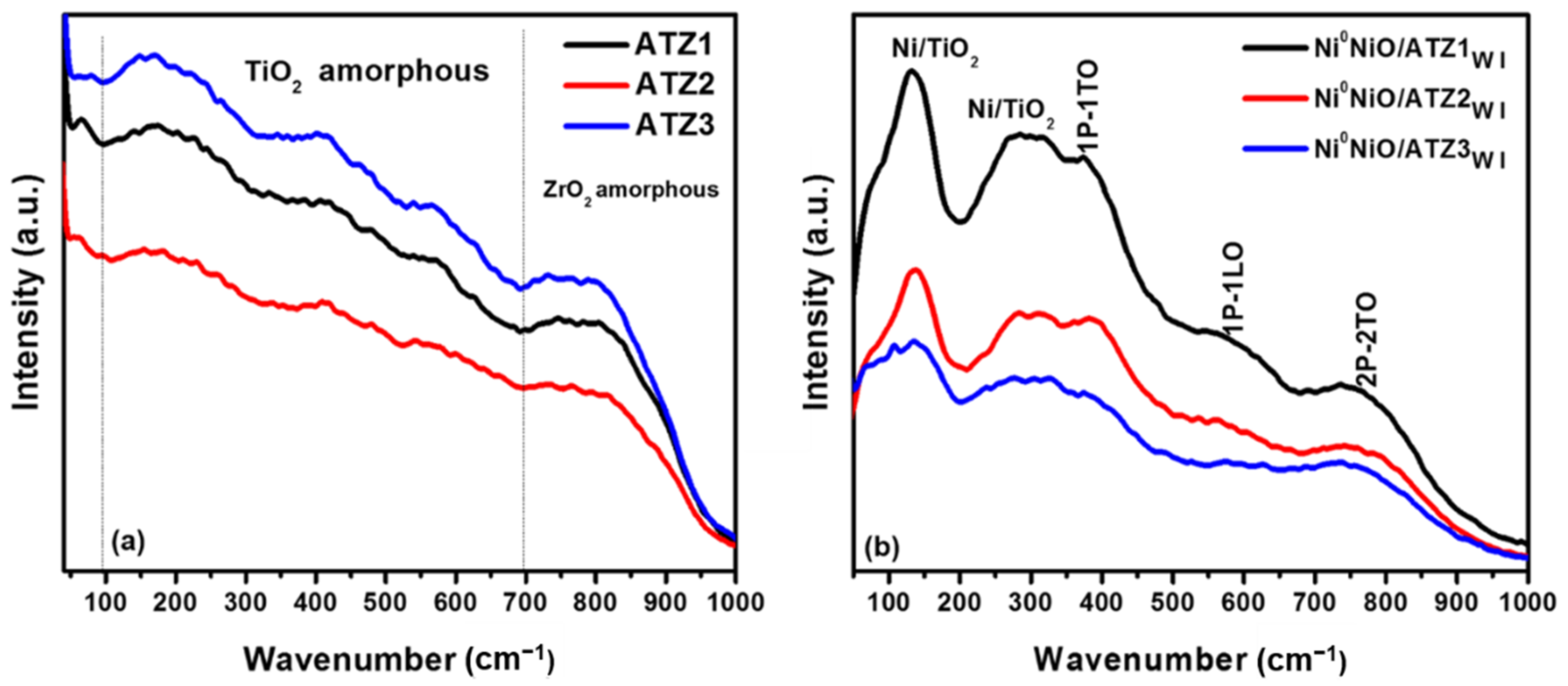

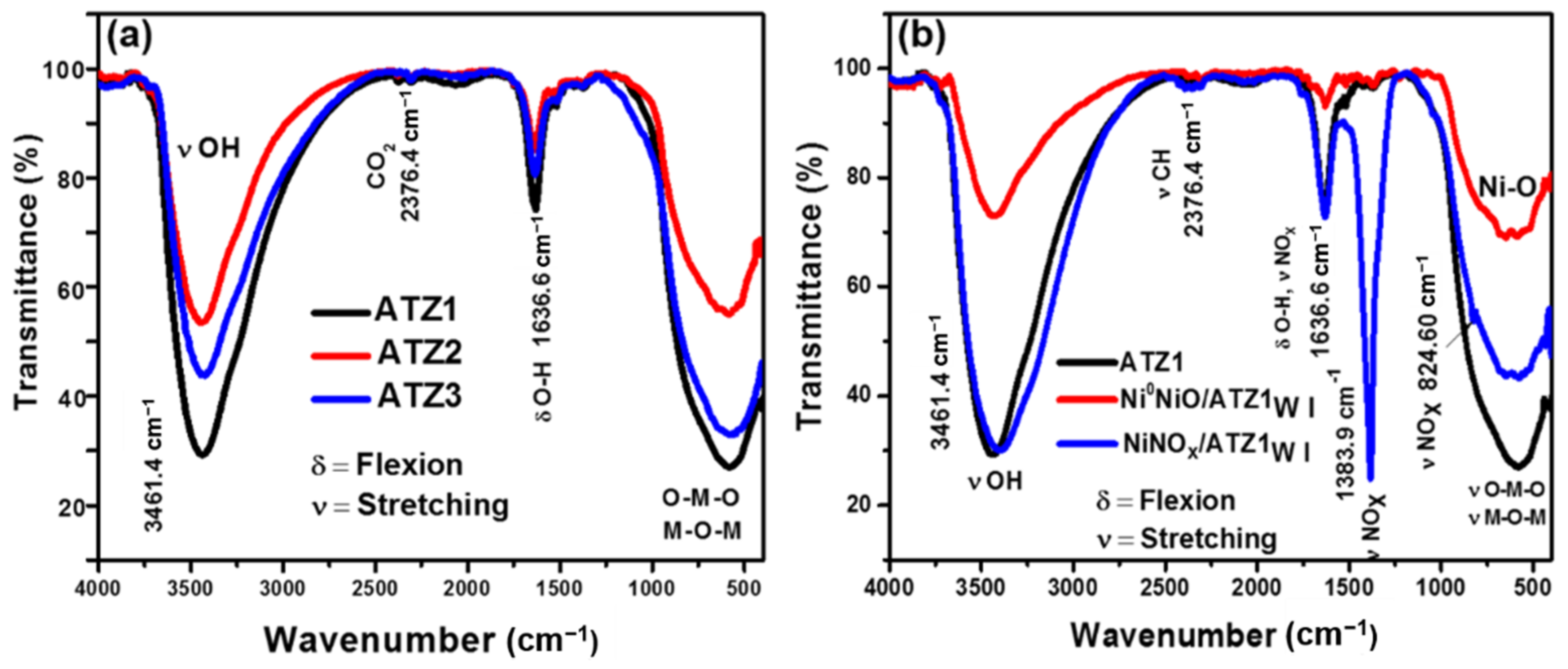
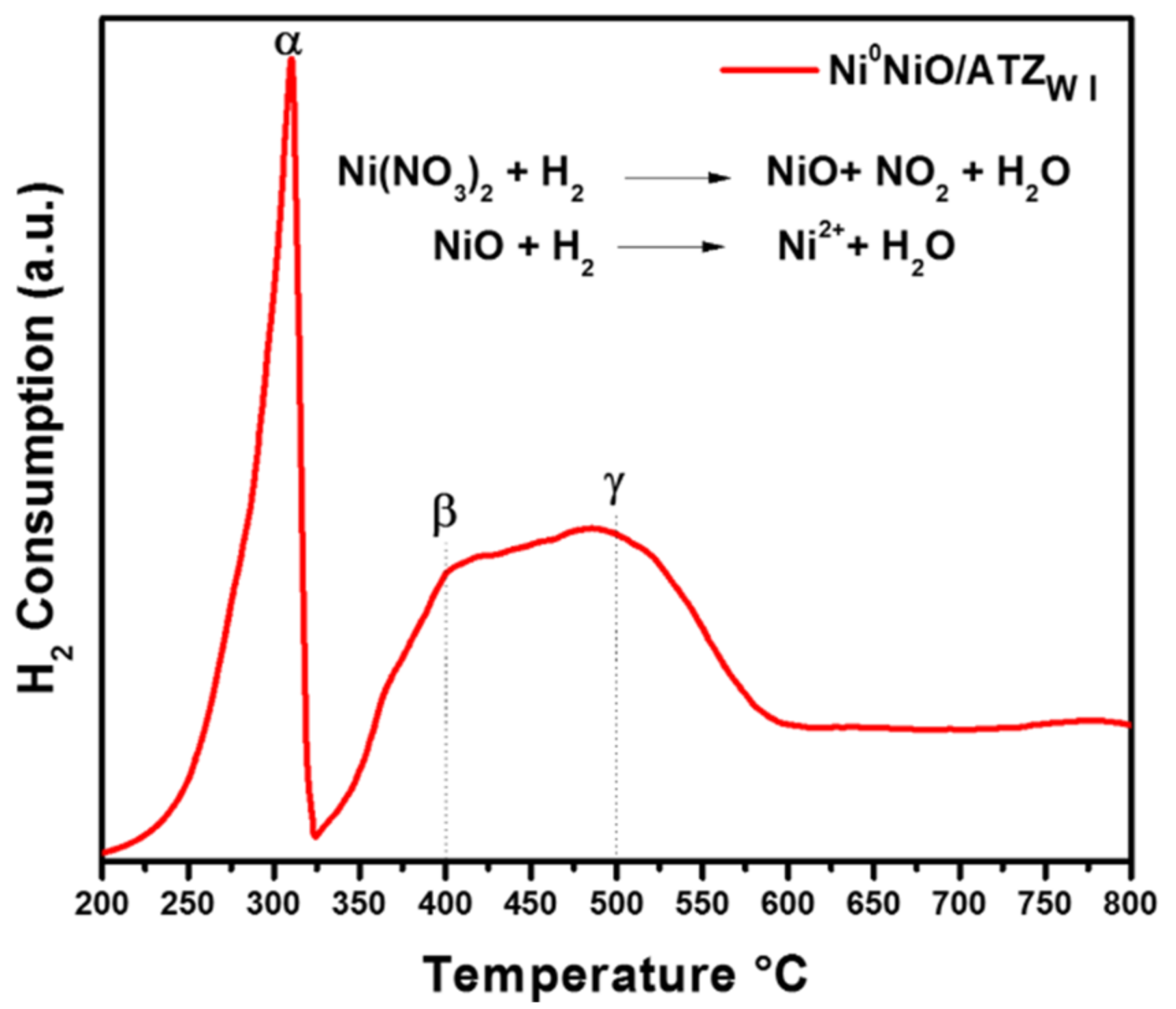
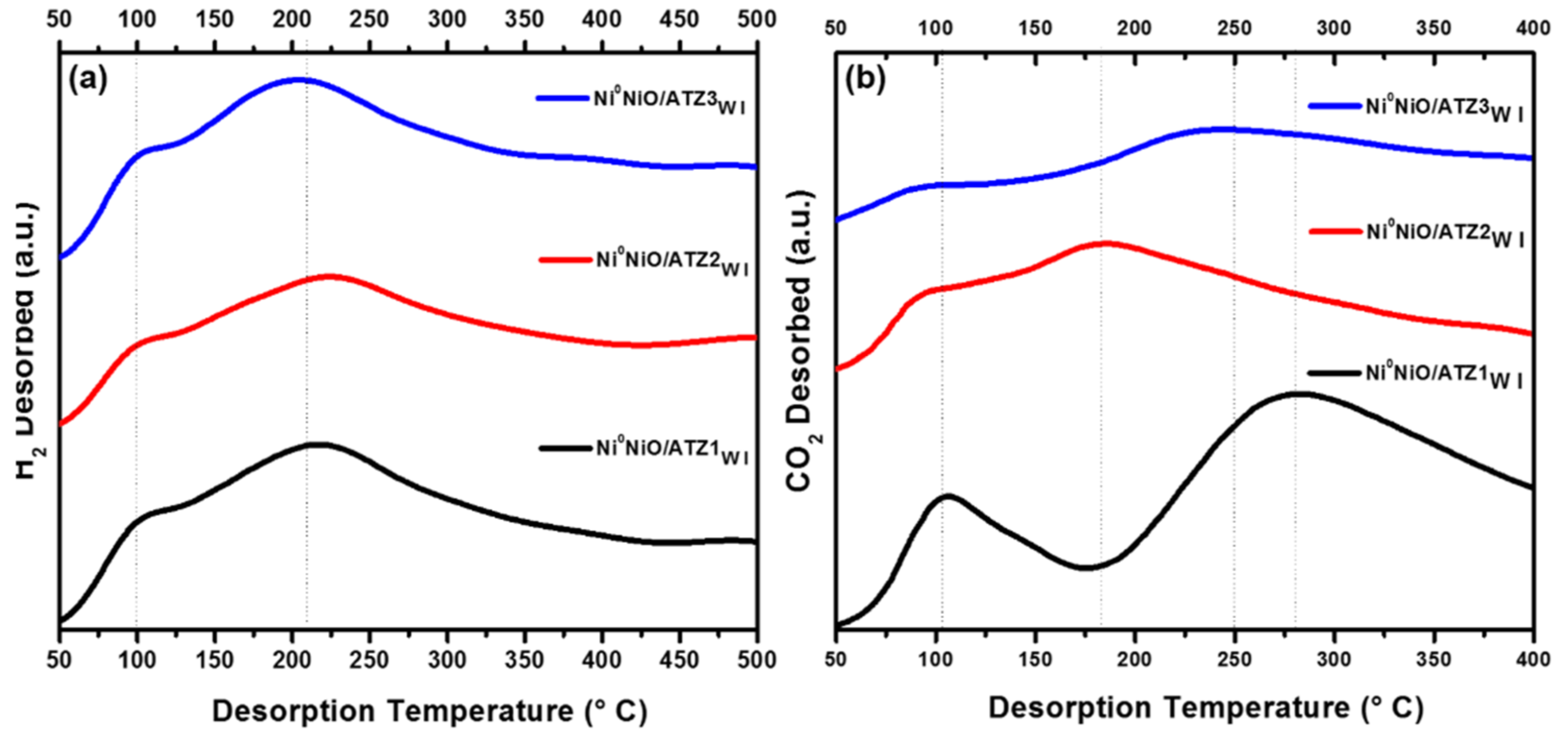
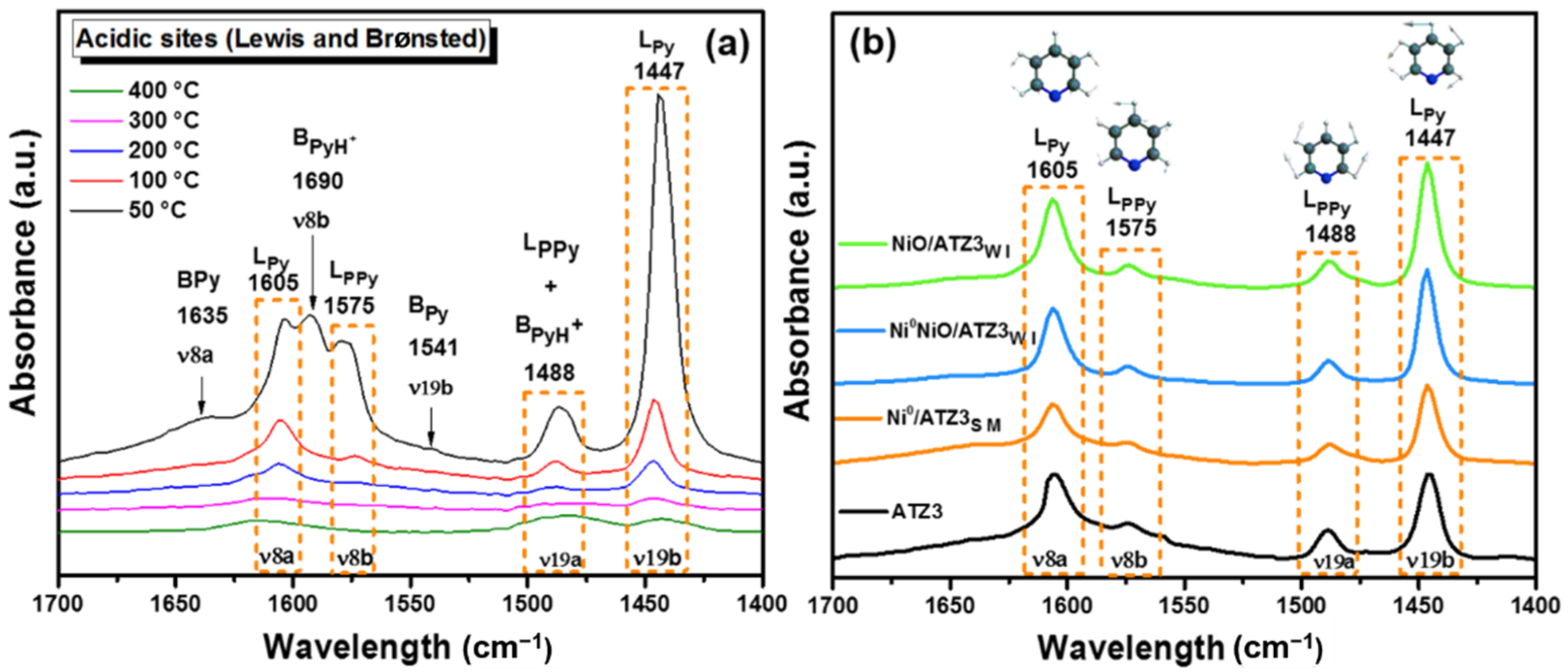
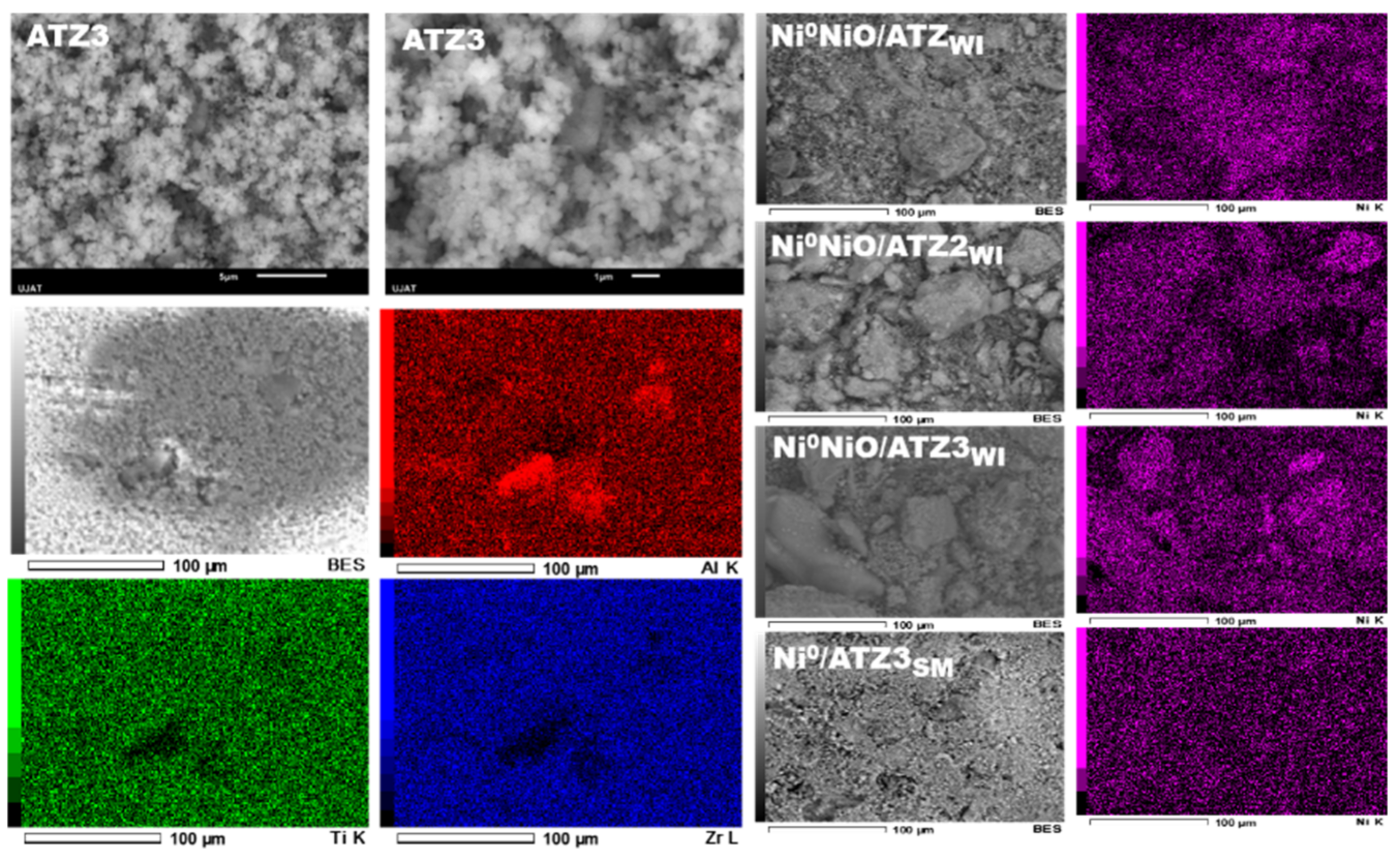
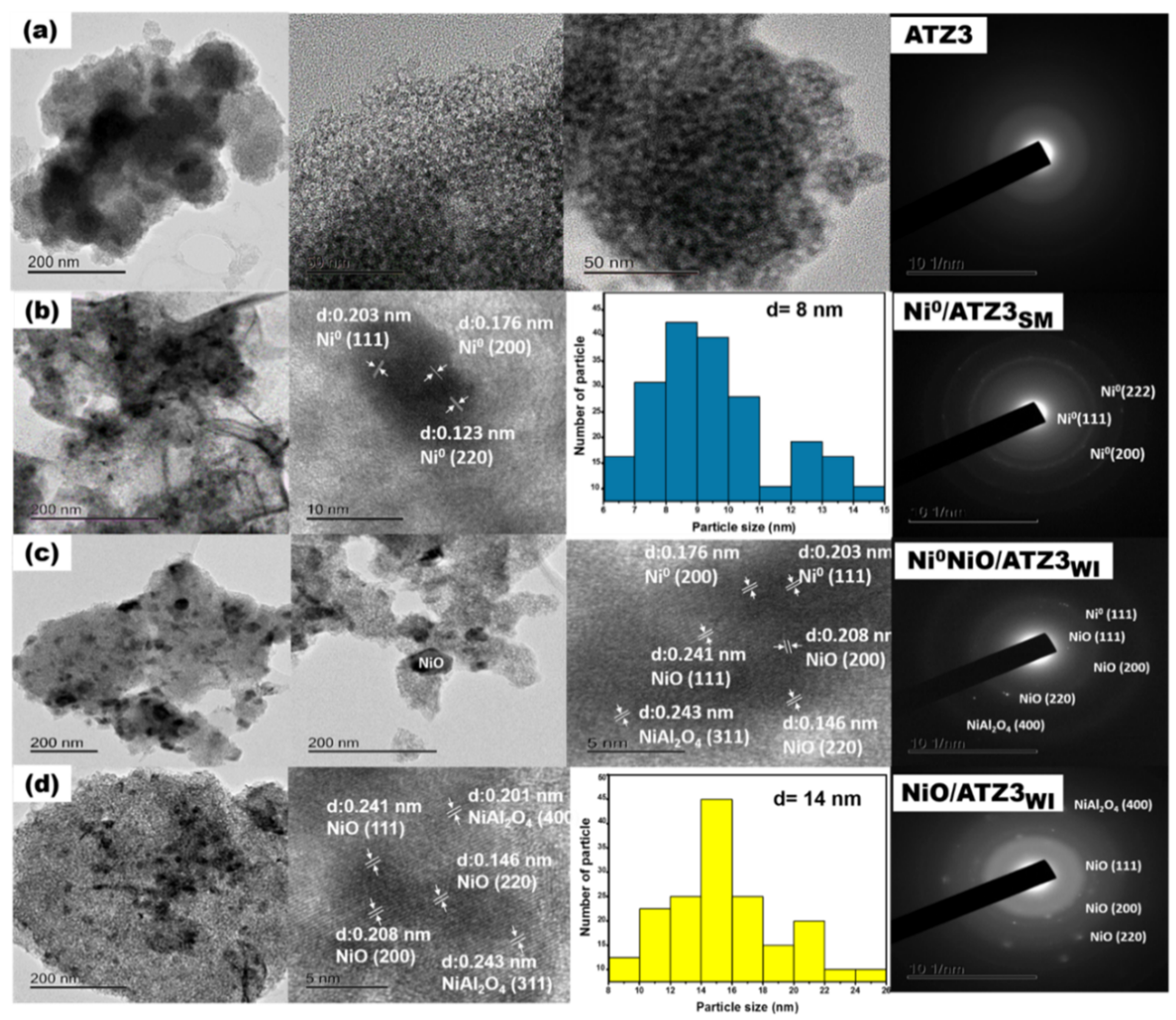
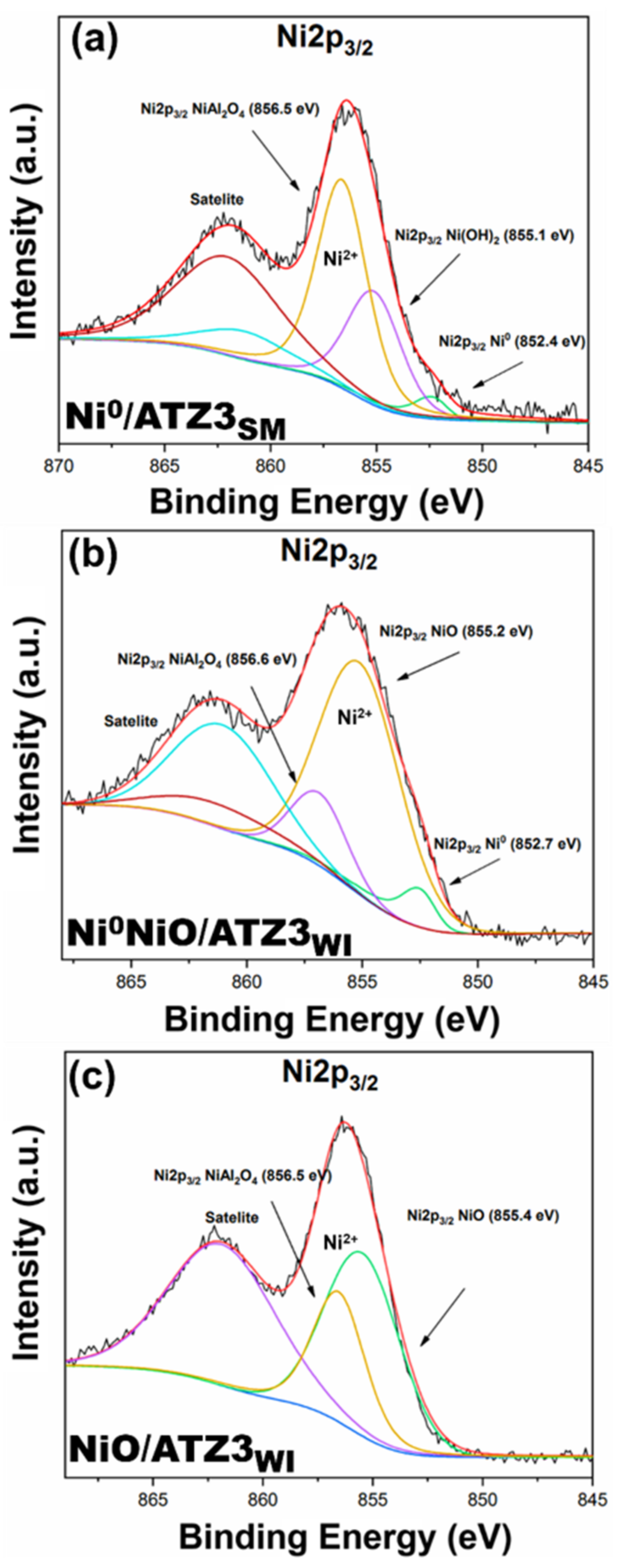

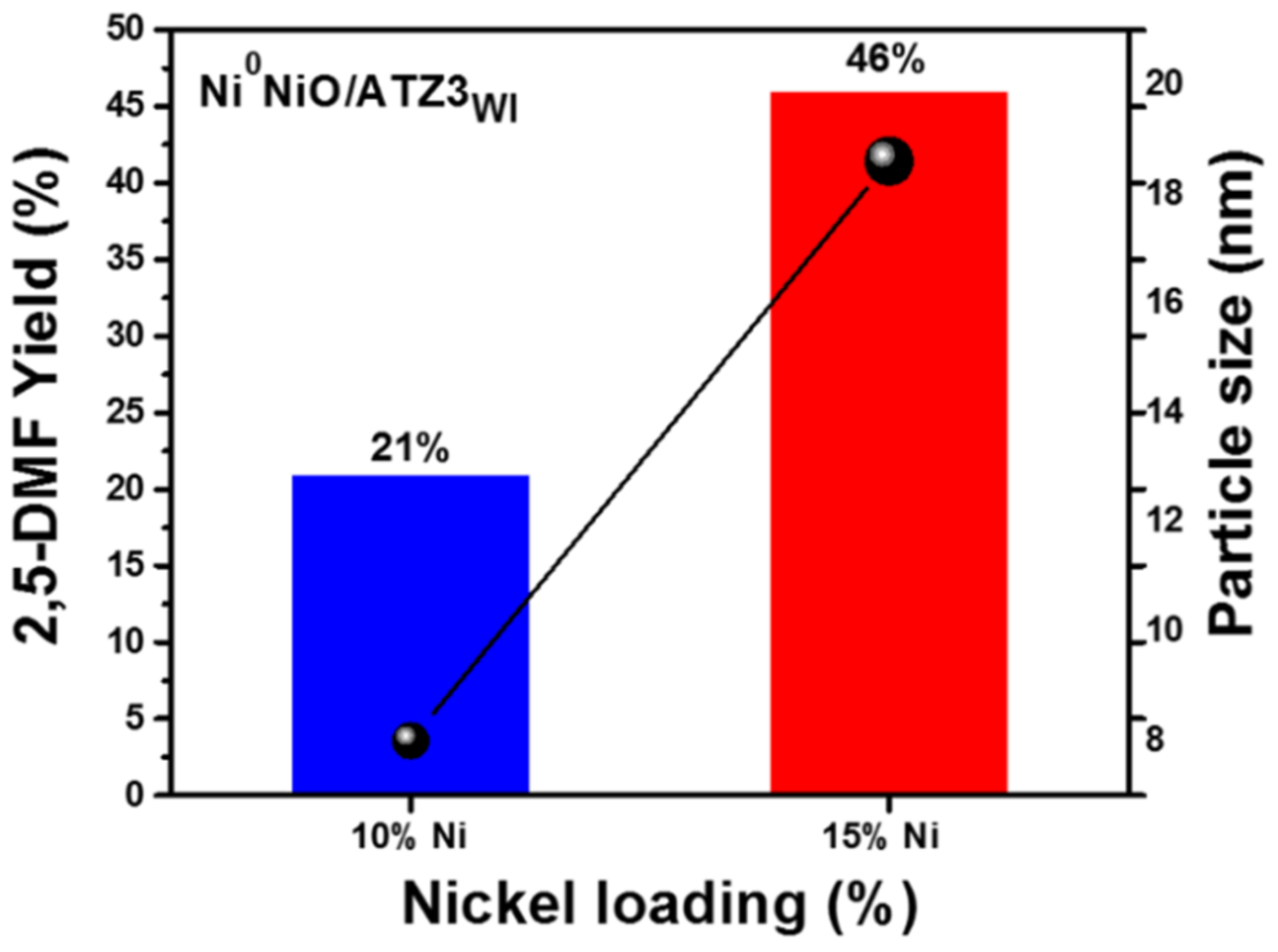
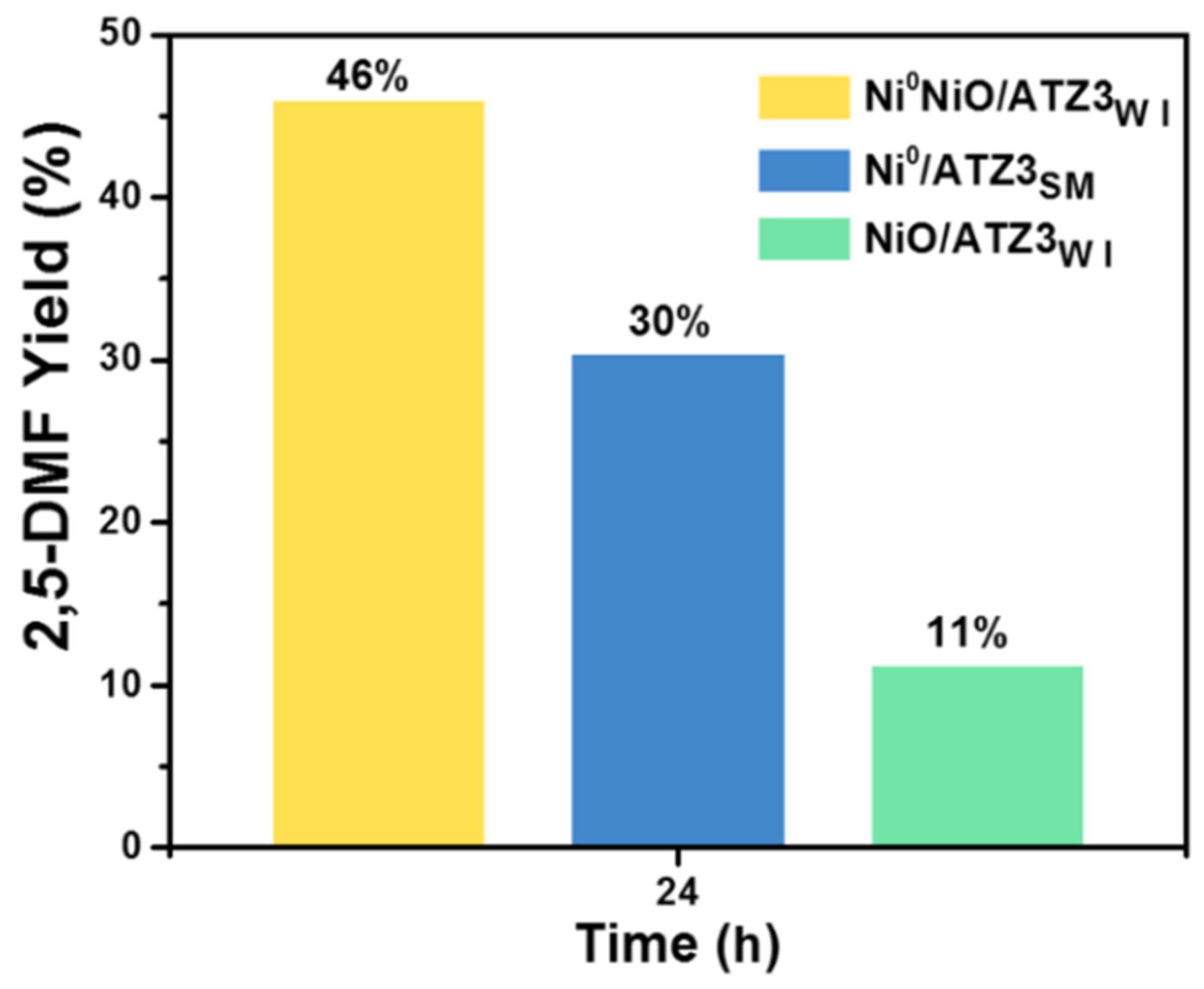


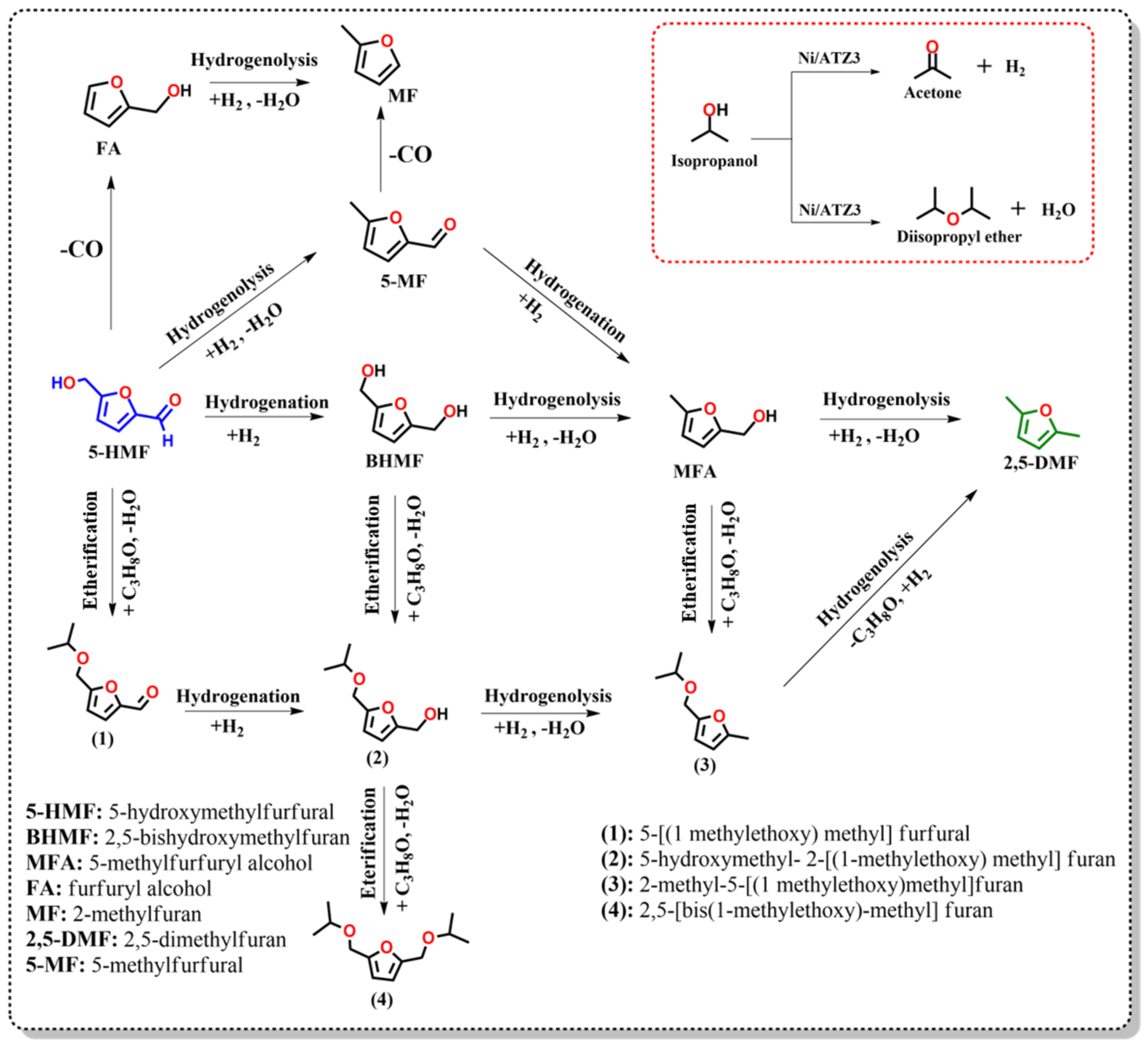
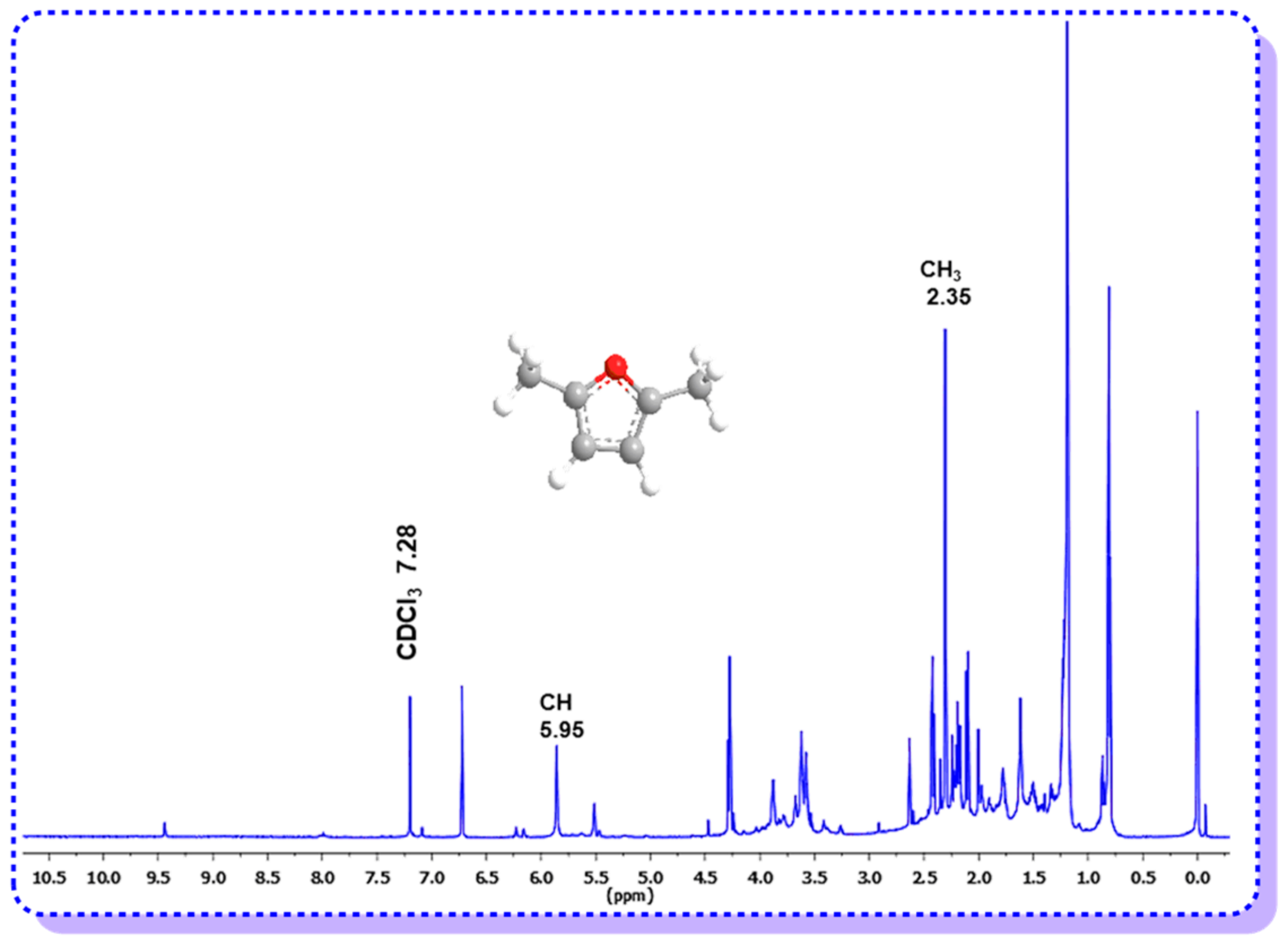
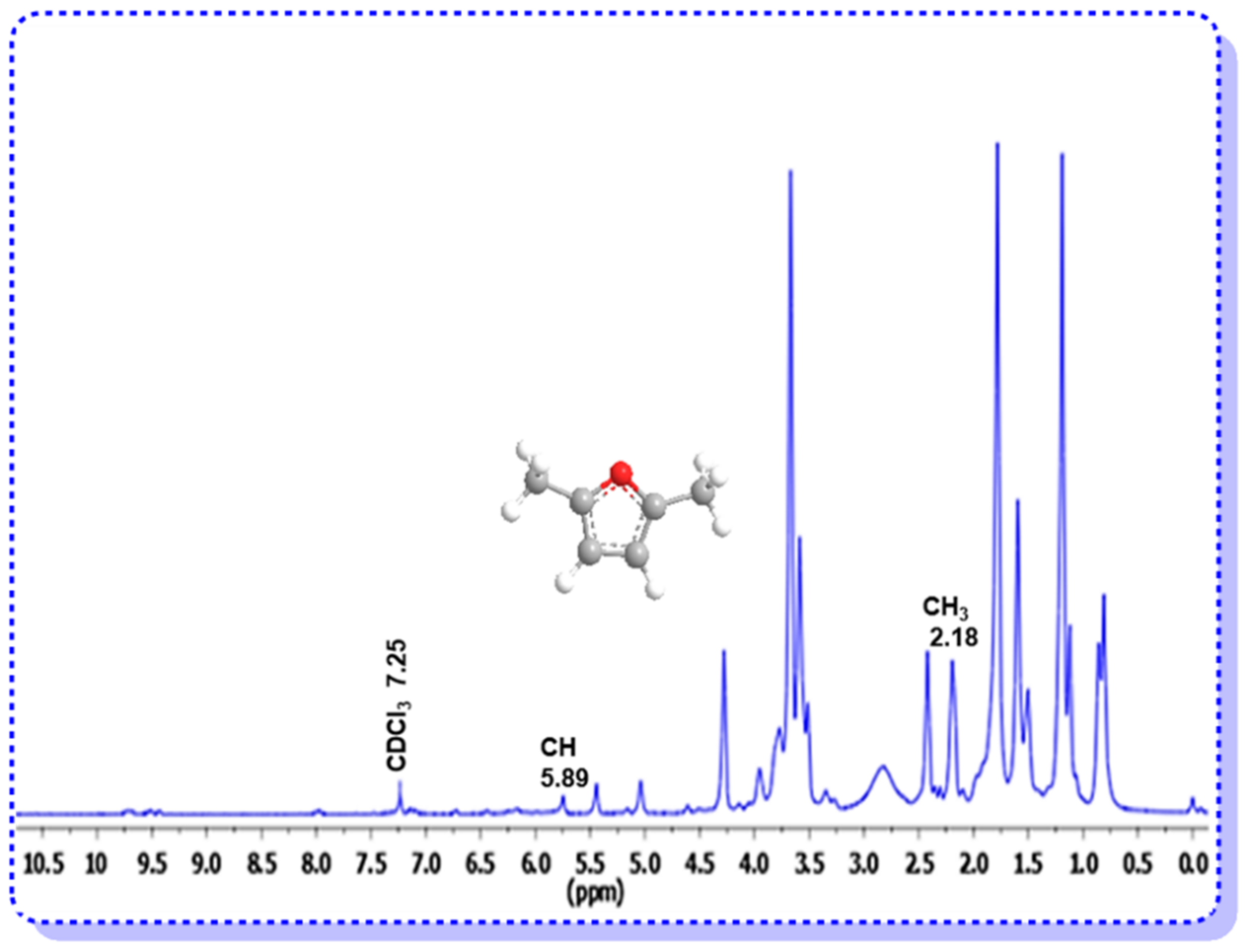

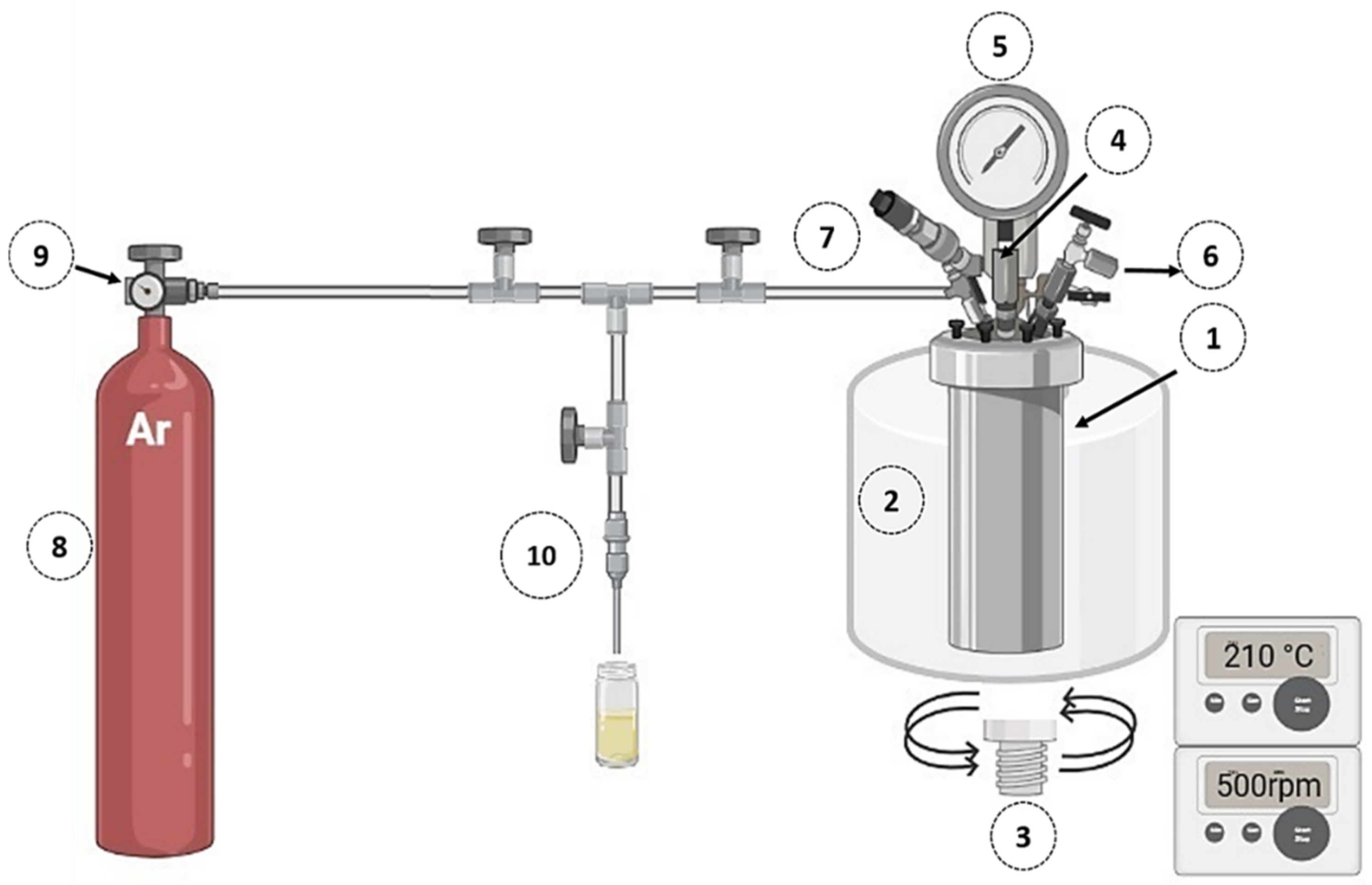
| Catalysts | Wt.% (Al2O3-TiO2-ZrO2) | Wt.% Ni | Surface Area SBET (m2/g) | Pore Size PD (nm) | Pore Volume VBJH (cm3/g) |
|---|---|---|---|---|---|
| ATZ1 | 33.33/33.33/33.33 | 0 | 258.78 | 5.98 | 0.53 |
| ATZ2 | 40/40/20 | 0 | 278.32 | 7.55 | 0.60 |
| ATZ3 | 20/40/40 | 0 | 210.65 | 4.12 | 0.34 |
| Ni0NiO/ATZWI | 33.33/33.33/33.33 | 15 | 192.56 | 5.01 | 0.33 |
| Ni0NiO/ATZ2WI | 40/40/20 | 15 | 203.40 | 6.76 | 0.43 |
| Ni0NiO/ATZ3WI | 20/40/40 | 15 | 184.77 | 4.03 | 0.26 |
| Ni0/ATZ1SM | 33.33/33.33/33.33 | 15 | 219.17 | 4.20 | 0.42 |
| Ni0/ATZ2SM | 40/40/20 | 15 | 205.56 | 5.43 | 0.39 |
| Ni0/ATZ3SM | 20/40/40 | 15 | 183.15 | 7.51 | 0.48 |
| NiO/ATZ3WI | 20/40/40 | 15 | 162.78 | 5.21 | 0.32 |
| Catalysts | Crystal Size (nm) Ni0/NiO (WI) | Crystal Size (nm) Ni0 (SM) | Crystal Size (nm) NiO (WI) |
|---|---|---|---|
| Ni/ATZ1 | 14.2 | 5 | - |
| Ni/ATZ2 | 17.7 | 7.6 | - |
| Ni/ATZ3 | 18 | 9.8 | 19.6 |
| Catalysts | SBET (m2/g) | H2-TPD (H/M μmol H2/gcat) | D (%) (H/M) | APS (nm) | Cristal Size by XRD (nm) |
|---|---|---|---|---|---|
| Ni0NiO/ATZ1WI | 192.56 | 184 | 7.19 | 13 | 14.2 |
| Ni0NiO/ATZ2 WI | 203.40 | 190 | 7.47 | 13.7 | 17.7 |
| Ni0NiO/ATZ3 WI | 184.77 | 194 | 7.55 | 14.7 | 19.6 |
| Catalysts | Distribution Area (%) and Strength Basic Sites | Adsorption Quantity (µmol CO2 g−1) | Basic Sites Density (µmol CO2 m−2) | SBET (m2/g) | |||
|---|---|---|---|---|---|---|---|
| Very Weak (80–250 °C) | Weak (250–380 °C) | Medium (380–450 °C) | Strong (450–550 °C) | ||||
| Ni0NiO/ATZ1WI | 35 | 5 | 60 | 0 | 880 | 4.60 | 192.56 |
| Ni0NiO/ATZ WI | 55 | 14 | 31 | 0 | 447 | 2.20 | 203.40 |
| Ni0NiO/ATZ3WI | 44 | 31 | 25 | 0 | 438 | 2.37 | 184.77 |
| Catalysts | Surface Area (m2/g) | Brønsted (μmolpy/gcat) | Lewis (μmolpy/gcat) | Density of Sites (μmolpy/m2) |
|---|---|---|---|---|
| Ni0/ATZ1SM | 219.17 | 0 | 108 | 0.49 |
| Ni0/ATZ2SM | 205.56 | 0 | 225 | 1.09 |
| Ni0/ATZ3SM | 183.15 | 0 | 103 | 0.56 |
| Ni0 NiO/ATZ1WI | 192.56 | 0 | 411 | 2.13 |
| Ni0 NiO/ATZ2WI | 203.40 | 0 | 220 | 1.08 |
| Ni0 NiO/ATZWI | 184.77 | 0 | 146 | 0.79 |
| NiO/ATZ3WI | 162.78 | 0 | 160 | 0.98 |
| Catalysts | Ni Species | Main Peak | Satellite Peak | Distribution of Surface Ni Species (%) | ||
|---|---|---|---|---|---|---|
| Binding Energy (eV) | FWHM | Binding Energy (eV) | FWHM | |||
| Ni0/ATZ3SM | Ni0 | 852.4 | 1.8 | - | - | 6.3 (Ni0) |
| Ni(OH)2 | 855.1 | 3 | 861.2 | 5 | 33.3 (Ni2+) | |
| NiAl2O4 | 856.5 | 2.8 | 862 | 5.8 | 60.4 (Ni2+) | |
| Ni0/NiO/ATZ3WI | Ni0 | 852.7 | 1.8 | - | - | 9.2 (Ni0) |
| NiO | 855.2 | 4.1 | 861.2 | 5 | 75.1 (Ni2+) | |
| NiAl2O4 | 856.6 | 2.8 | 861.4 | 5.8 | 15.7 (Ni2+) | |
| NiO/ATZ3WI | Ni0 | - | - | - | - | - |
| NiO | 855.4 | 4.1 | 861.2 | 5 | 63.7 (Ni2+) | |
| NiAl2O4 | 856.5 | 2.8 | 861.4 | 5.8 | 36.3 (Ni2+) | |
Publisher’s Note: MDPI stays neutral with regard to jurisdictional claims in published maps and institutional affiliations. |
© 2022 by the authors. Licensee MDPI, Basel, Switzerland. This article is an open access article distributed under the terms and conditions of the Creative Commons Attribution (CC BY) license (https://creativecommons.org/licenses/by/4.0/).
Share and Cite
Cortez-Elizalde, J.; Córdova-Pérez, G.E.; Silahua-Pavón, A.A.; Pérez-Vidal, H.; Cervantes-Uribe, A.; Cordero-García, A.; Arévalo-Pérez, J.C.; Becerril-Altamirano, N.L.; Castillo-Gallegos, N.C.; Lunagómez-Rocha, M.A.; et al. 2,5-Dimethylfuran Production by Catalytic Hydrogenation of 5-Hydroxymethylfurfural Using Ni Supported on Al2O3-TiO2-ZrO2 Prepared by Sol-Gel Method: The Effect of Hydrogen Donors. Molecules 2022, 27, 4187. https://doi.org/10.3390/molecules27134187
Cortez-Elizalde J, Córdova-Pérez GE, Silahua-Pavón AA, Pérez-Vidal H, Cervantes-Uribe A, Cordero-García A, Arévalo-Pérez JC, Becerril-Altamirano NL, Castillo-Gallegos NC, Lunagómez-Rocha MA, et al. 2,5-Dimethylfuran Production by Catalytic Hydrogenation of 5-Hydroxymethylfurfural Using Ni Supported on Al2O3-TiO2-ZrO2 Prepared by Sol-Gel Method: The Effect of Hydrogen Donors. Molecules. 2022; 27(13):4187. https://doi.org/10.3390/molecules27134187
Chicago/Turabian StyleCortez-Elizalde, Jorge, Gerardo E. Córdova-Pérez, Adib Abiu Silahua-Pavón, Hermicenda Pérez-Vidal, Adrián Cervantes-Uribe, Adrián Cordero-García, Juan Carlos Arévalo-Pérez, Norma Leticia Becerril-Altamirano, Nayi Cristel Castillo-Gallegos, María Antonia Lunagómez-Rocha, and et al. 2022. "2,5-Dimethylfuran Production by Catalytic Hydrogenation of 5-Hydroxymethylfurfural Using Ni Supported on Al2O3-TiO2-ZrO2 Prepared by Sol-Gel Method: The Effect of Hydrogen Donors" Molecules 27, no. 13: 4187. https://doi.org/10.3390/molecules27134187
APA StyleCortez-Elizalde, J., Córdova-Pérez, G. E., Silahua-Pavón, A. A., Pérez-Vidal, H., Cervantes-Uribe, A., Cordero-García, A., Arévalo-Pérez, J. C., Becerril-Altamirano, N. L., Castillo-Gallegos, N. C., Lunagómez-Rocha, M. A., Díaz de León, J. N., Guerra-Que, Z., Espinosa de los Monteros, A. E., & Torres-Torres, J. G. (2022). 2,5-Dimethylfuran Production by Catalytic Hydrogenation of 5-Hydroxymethylfurfural Using Ni Supported on Al2O3-TiO2-ZrO2 Prepared by Sol-Gel Method: The Effect of Hydrogen Donors. Molecules, 27(13), 4187. https://doi.org/10.3390/molecules27134187







